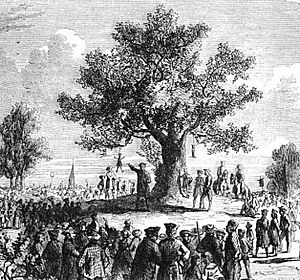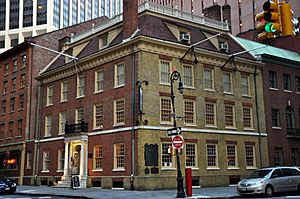Committees of correspondence facts for kids
The committees of correspondence were groups of American leaders who worked together to oppose the British government. Later, they helped gain support for American independence during the American Revolution. Samuel Adams, a Patriot from Boston, came up with the idea. These committees created a secret network to share information among Patriot leaders in the Thirteen Colonies by writing letters. They were very important in organizing the First Continental Congress, which met in Philadelphia in 1774.
Contents
What They Did
The main job of these committees was to tell people in each colony what the British Crown was doing. They also spread news from cities to the countryside. News usually traveled through handwritten letters or printed pamphlets. Couriers carried these messages on horseback or by ship.
The committees made sure this news showed the views of the Patriots. They also made sure the news reached the right groups. Many members of these committees were also part of colonial governments. Some were also active in groups like the Sons of Liberty.
About 7,000 to 8,000 Patriots served on these committees. They were often leaders in their communities. People who supported the British King were not included. These committees became the main leaders of the American resistance against Great Britain. They largely guided the Revolutionary War efforts at the local and state levels.
The committees encouraged people to be proud of America. They also promoted making goods at home. They advised Americans to avoid expensive items and live a simpler life. Over time, these committees gained more power in American public life. In late 1774 and early 1775, they helped organize elections for new local governments. These new governments started to act like real colonial governments.
How They Started
The first committees of correspondence began in Boston in 1764. Their goal was to oppose the Currency Act. They also protested unpopular changes to the customs service.
The next year, during the Stamp Act crisis, New York formed a committee. It urged other colonies to resist the new taxes together. The Massachusetts committees then asked other colonies to send delegates to the Stamp Act Congress. These early committees broke up after the crisis ended.
In late 1772, Patriot leaders in Boston, like Samuel Adams, believed the British government was becoming more threatening. So, they set up the first long-lasting committee. By spring 1773, Patriots decided to copy Massachusetts' system. They started forming their own committees in each colony. Virginia appointed an eleven-member committee in March. Soon after, Rhode Island, Connecticut, New Hampshire, and the South Carolina followed. By February 1774, 11 colonies had committees. Only North Carolina and Pennsylvania did not have them yet.
Delaware
In Delaware Colony, Thomas McKean started a committee of correspondence. This happened after ten years of disagreements in New Castle County. In nearby Kent County, Caesar Rodney set up another committee. Then Sussex County formed one too.
After the First Continental Congress met in 1774, these committees changed. They were replaced by elected "committees of inspection." These new committees focused on gathering information. They especially looked for people who didn't support the American cause. These committees were very important in making more people want independence.
The correspondence committees shared information with groups in Boston, Philadelphia, and other places. Their leaders often became important executive leaders in Delaware. The committees of inspection used public announcements to discourage unhappiness and encourage patriotism. When imports from Britain stopped, the committees wanted America to make its own goods. So, they encouraged growing flax and raising sheep for wool. The committees also helped organize local militias. With their encouragement, the Delaware Assembly chose delegates for the Continental Congress who supported independence.
Massachusetts
In November 1772, in the Province of Massachusetts Bay, Samuel Adams, Joseph Warren, and Mercy Otis Warren formed a committee. They did this because of the Gaspée Affair. Also, the British had decided to pay the royal governor's and judges' salaries themselves. This meant the colony could no longer control these officials.
In the next few months, over a hundred more committees formed in towns across Massachusetts. The Massachusetts committee's main office was in Boston. It was led by Adams and became a model for other Patriot groups. The meeting that started the committee explained its goal: to state "the rights of the colonists... as men, as Christians, and as subjects." They wanted to share this message with all towns in the province and the world.
Maryland
The Province of Maryland was the eighth colony to appoint a committee of correspondence. This happened on October 15, 1773. The Maryland committee said it was "absolutely necessary" for the colonies to unite to protect their shared freedoms. They called for a meeting of this union in Philadelphia.
New York
When news arrived that the Port of Boston would be closed by the Boston Port Act, an announcement was put up. It was at the coffee house on Wall Street in New York City, a popular spot for ship captains and merchants. The announcement invited merchants to meet on May 16, 1774, at the Fraunces Tavern. They wanted to "consult on measures" for the "critical situation."
At the meeting, led by Isaac Low, they decided to name a 50-member committee of correspondence. This list would be shown to the public. On May 17, 1774, they announced a public meeting for May 19. At that meeting, Francis Lewis was also nominated. The entire Committee of Fifty-one was then approved.
On May 23, 1774, the committee met and chose Isaac Low as chairman and John Alsop as deputy chairman. They then formed a smaller group. This group wrote a letter responding to Boston's letters. It called for a "Congress of Deputies from the Colonies" to meet. This meeting later became known as the First Continental Congress. The committee approved this idea.
On May 30, 1774, the Committee formed another small group. This group wrote a letter to New York's county leaders. It urged them to form similar committees of correspondence. The Committee adopted this letter on May 31.
On July 4, 1774, a decision was made to appoint five delegates. This depended on the approval of property owners in New York City and County. They also asked other counties to send delegates. Isaac Low, John Alsop, James Duane, Philip Livingston, and John Jay were appointed. The public was invited to City Hall on July 7 to approve these choices. This caused some tension with the more radical Sons of Liberty. They held their own meeting on July 6. Three counties—Westchester, Dutchess, and Albany—agreed to the five delegates. But three other counties—Kings, Suffolk, and Orange—sent their own delegates.
North Carolina
By 1773, the political situation was getting worse. People were worried about the courts. Josiah Quincy Jr., a young Patriot from Boston, visited North Carolina for five days. On March 26, 1773, he stayed at Cornelius Harnett's home near Wilmington, North Carolina. They discussed and planned for a Committee of Correspondence. The committee's goal was to share news and revolutionary feelings among the colonies. After this meeting, Quincy called Harnett the "Samuel Adams of North Carolina."
In December 1773, the North Carolina Committee of Correspondence formed in Wilmington. Even though Harnett was not there, he was made chairman. Other members included John Harvey, Robert Howe, Richard Caswell, Edward Vail, John Ashe, Joseph Hewes, Samuel Johnston, and William Hooper.
Pennsylvania
The Province of Pennsylvania was one of the last to form a committee of correspondence. They did so at a meeting in Philadelphia on May 20, 1774. To satisfy both radical and conservative groups, the committee was formed by combining their suggested lists. This committee started with 19 members. It grew to 43, then 66, and finally to two different groups of 100 members. This happened between May 1774 and its end in September 1776. In total, 160 men from Pennsylvania served on one or more of these committees. Only four were regularly elected to all of them: Thomas Barclay, John Cox Jr., John Dickinson, and Joseph Reed.
Virginia
In early March 1773, Dabney Carr suggested forming a permanent Committee of Correspondence. He proposed this to the Virginia House of Burgesses. Virginia's own committee was formed on March 12, 1773. Its members included Peyton Randolph, Robert Carter Nicholas, Richard Bland, Richard Henry Lee, Benjamin Harrison, Edmund Pendleton, Patrick Henry, Dudley Digges, Dabney Carr, Archibald Cary, and Thomas Jefferson.
Other Colonies
By July 1773, Rhode Island, Connecticut, New Hampshire, and South Carolina had also formed committees.
With Pennsylvania's action in May 1774, all the colonies that eventually rebelled had set up these committees.
These colonial committees successfully organized resistance to the Tea Act. They even got doctors to write that drinking tea would make Americans "weak" and "sick for life."
These permanent committees did important planning for the First Continental Congress. This Congress met in September 1774. The Second Congress later created its own committee of correspondence. Its job was to explain the American view of events to other countries.
During the Revolution, these committees were replaced by Provincial Congresses.
By 1780, committees of correspondence had also formed in Great Britain and Ireland.
See also



